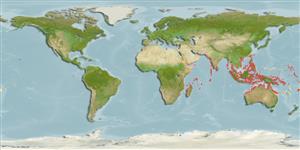Common names from other countries
>
Blenniiformes (Blennies) >
Blenniidae (Combtooth blennies) > Blenniinae
Etymology: Petroscirtes: Latin, petra, -ae = stone + Greek, skirteo = to jump.
Environment: milieu / climate zone / depth range / distribution range
Ecología
marino asociado a arrecife; rango de profundidad 1 - 10 m (Ref. 86942). Tropical; 25°N - 24°S
Indo-West Pacific: Sri Lanka to Fiji, north to southern Taiwan and the Yaeyama Islands, south to the southern Great Barrier Reef.
Tamaño / Peso / Age
Maturity: Lm ? range ? - ? cm
Max length : 15.0 cm TL macho / no sexado; (Ref. 9710)
Short description
Claves de identificación | Morfología | Morfometría
Espinas dorsales (total) : 10 - 11; Radios blandos dorsales (total) : 16 - 19; Espinas anales: 2; Radios blandos anales: 16 - 19. Sexually dimorphic: males are orange-brown while females are sea-green dorsally and lighter below. Similar to P. breviceps in shape but has a blotched, rather than lined pattern on the body. Some color form are probably habitat related. The plain form is mainly green and has numerous tiny pearly spots and occurs in seagrass beds (Ref. 48636).
Adults occur in seagrass beds of shallow lagoons. Also in Sargassum rafts during or immediately after wet season (Ref. 48636). Replaced by P. thepassi at Solomon Islands (Ref. 90102). They feed primarily on small crustaceans and occasionally on scales from fishes. Oviparous. Eggs are demersal and adhesive (Ref. 205), and are attached to the substrate via a filamentous, adhesive pad or pedestal (Ref. 94114). Larvae are planktonic, often found in shallow, coastal waters (Ref. 94114). This form was named by Bleeker (1852) as Petroscirtes bankanensis.
Life cycle and mating behavior
Maturities | Reproducción | Spawnings | Egg(s) | Fecundities | Larva
Oviparous, distinct pairing (Ref. 205).
Myers, R.F., 1991. Micronesian reef fishes. Second Ed. Coral Graphics, Barrigada, Guam. 298 p. (Ref. 1602)
IUCN Red List Status (Ref. 130435)
CITES (Ref. 128078)
Not Evaluated
Threat to humans
Harmless
Human uses
Herramientas
Special reports
Download XML
Fuentes de Internet
Estimates based on models
Preferred temperature (Ref.
115969): 26 - 29.3, mean 28.6 (based on 2654 cells).
Phylogenetic diversity index (Ref.
82804): PD
50 = 0.5005 [Uniqueness, from 0.5 = low to 2.0 = high].
Bayesian length-weight: a=0.00562 (0.00258 - 0.01228), b=3.06 (2.87 - 3.25), in cm Total Length, based on LWR estimates for this (Sub)family-body shape (Ref.
93245).
Nivel trófico (Ref.
69278): 3.1 ±0.43 se; based on food items.
Resiliencia (Ref.
120179): Alto, población duplicada en un tiempo mínimo inferior a 15 meses (Preliminary K or Fecundity.).
Fishing Vulnerability (Ref.
59153): Low vulnerability (10 of 100).
